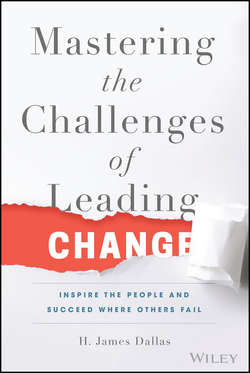Читать книгу Mastering the Challenges of Leading Change - James Dallas H. - Страница 4
На сайте Литреса книга снята с продажи.
Foreword
ОглавлениеBill Hawkins
President and CEO, Immucor
Someone once said, “When the rate of external change exceeds the rate of internal change, the end is in sight.” That's a difficult reality for business today because the rate of external change in most industries is dizzyingly fast and accelerating still. Leaders need skills optimized to help people adapt, perform, and innovate in this turbulent environment.
Medtronic, the company where James Dallas and I worked together, operates in health care, by its nature a very dynamic environment. But there was probably no more dynamic period in the company's history than the period we worked together during which I was the CEO and James was the CIO. No situation could better prepare a leader to write a book on change, or even the book on change. James not only had a front-row seat, he was instrumental in helping us control our destiny and zig when everyone else was zagging.
Medtronic's culture is rooted in the five-point mission statement that our founder Earl Bakken wrote in 1960, focused on alleviating pain, restoring health, and extending life through innovative medical products. People's lives were dependent on our judgment, our actions, and our values. It was the mission that guided us to do the right thing every day, whether it meant suspending shipment of our number-one product when it fell short of our own performance expectations or increasing our investment in R&D when others were cutting back due to the economic downturn.
James was hired in 2006 to lead an initiative to implement a company-wide enterprise resource planning (ERP) system. This was technically challenging on its own, but it also required overcoming one of the company's biggest leadership challenges: how to align an enterprise that was made up of many distinct businesses. The company had gone through a significant acquisition spree in the late 1990s and early 2000s, and each business was protective of its autonomy. To succeed in his mandate, James had to obtain extraordinary commitment from a lot of different people, across multiple businesses and geographies, many of whom didn't initially see the value of having a unified system. Even among those who saw the value, there were many who doubted it could ever be successfully implemented. It was a huge leadership challenge, and even more so because he started out as an outsider – some guy from Atlanta. What we didn't anticipate was the economic downturn in 2008 or the uncertainty in our industry caused by the Affordable Care Act. As another former CEO of Medtronic and now a professor at Harvard, Bill George recently said, “Never waste a good crisis.” James was not one to waste a crisis or to let external forces disrupt internal goals. He never wavered. He delivered.
When we interviewed James for Medtronic, I felt that he was the guy that you wanted to take a chance on. It was more than his track record. James was both confident and humble, he had a strong IQ and EQ, and he was authentic and principled – the guy you listen to when the stakes are high and the obstacles to change are great. Remarkably, the stories and lessons in this book help elucidate the actions and habits that add up to that level of executive presence, and the traits that allow for successful follow-through thereafter. Things like extraordinary transparency and disciplined execution, and the ability to recognize and groom talent and rally people to the finish line.
One of the recurring themes of the advice in this book is also one of the things I respected most about James: He never hesitated to roll his shirtsleeves up. Every quarter, at any public company, there's a big push to make sure you finish strong. The nature of our business meant that there were a lot of products that got shipped out in the last three or four days of the quarter. James would clear his calendar so that he could be on the ground in the distribution center or working with customer service until midnight when we closed the books. Seeing senior management right there on the floor, serving coffee or doughnuts or pizza, running interference or making decisions, made a huge difference for people. Because of James, they didn't mind working late.
That was something we had in common. We never expected anything of anybody that we didn't expect of ourselves. People felt that. They felt a sense of responsibility, or even of duty, to a senior leader who was willing to get in the trenches with them.
James is one of few change agents who has lived to tell the tale, and anyone who reads this book will benefit from his remarkable storytelling. On top of all this, it could be said that James epitomizes the American Dream. Relying only on the currency of principle, purpose, and ambition, he's an African-American man who went from nobody in Georgia to CIO of a major Fortune 500 company. Sadly it's almost uncommon these days to find people who have not only climbed the ladder from the bottom, but have done so with integrity as their primary strength.
James did exactly that. I hope his book guides many other change agents to lead their companies to greatly exceed the rate of external change – with the full weight of their character propelling them.
